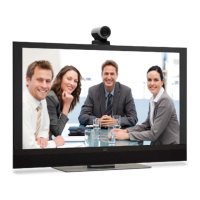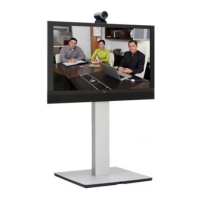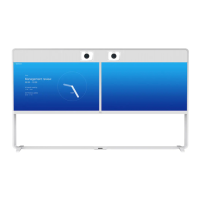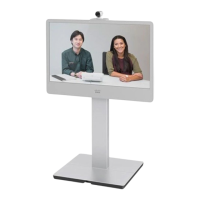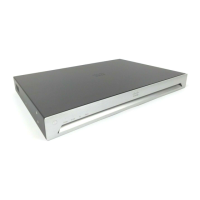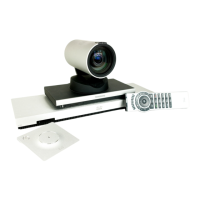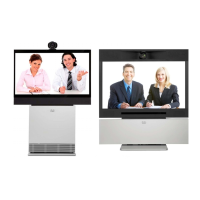D15119.02 MX700 and MX800 Administrator Guide TC7.2, AUGUST 2014. www.cisco.com — Copyright © 2014 Cisco Systems, Inc. All rights reserved.
115
Cisco TelePresence MX700 and MX800 Administrator Guide
Video SelfviewDefault Mode
Determine if the main video source (self-view) shall be displayed on screen after a call.
The position and size of the self-view window is determined by the Video SelfviewDefault
PIPPosition and the Video SelfviewDefault FullscreenMode settings respectively.
Requires user role: ADMIN
Value space: <Off/Current/On>
Off: self-view is switched off when leaving a call.
Current: self-view is left as is, i.e. if it was on during the call, it remains on after the call; if it
was off during the call, it remains off after the call.
On: self-view is switched on when leaving a call.
Example:
Video SelfviewDefault Mode: Current
Video SelfviewDefault FullscreenMode
Determine if the main video source (self-view) shall be shown in full screen or as a small
picture-in-picture (PiP) after a call. The setting only takes effect when self-view is switched on
(see the Video SelfviewDefault Mode setting).
Requires user role: ADMIN
Value space: <Off/Current/On>
Off: self-view will be shown as a PiP.
Current: The size of the self-view picture will be kept unchanged when leaving a call, i.e. if it
was a PiP during the call, it remains a PiP after the call; if it was fullscreen during the call, it
remains fullscreen after the call.
On: The self-view picture will be shown in fullscreen.
Example:
Video SelfviewDefault FullscreenMode: Current
Video SelfviewDefault PIPPosition
Determine the position on screen of the small self-view picture-in-picture (PiP) after a call. The
setting only takes effect when self-view is switched on (see the Video SelfviewDefault Mode
setting) and fullscreen view is switched off (see the Video SelfviewDefault FullscreenMode
setting).
Requires user role: ADMIN
Value space: <Current/UpperLeft/UpperCenter/UpperRight/CenterLeft/CenterRight/LowerLeft/
LowerRight >
Current: The position of the self-view PiP will be kept unchanged when leaving a call.
UpperLeft: The self-view PiP will appear in the upper left corner of the screen.
UpperCenter: The self-view PiP will appear in the upper center position.
UpperRight: The self-view PiP will appear in the upper right corner of the screen.
CenterLeft: The self-view PiP will appear in the center left position.
CentreRight: The self-view PiP will appear in the center right position.
LowerLeft: The self-view PiP will appear in the lower left corner of the screen.
LowerRight: The self-view PiP will appear in the lower right corner of the screen.
Example:
Video SelfviewDefault PIPPosition: Current
Video SelfviewDefault OnMonitorRole
Determine which monitor/output to display the main video source (self-view) on after a call. The
value reflects the monitor roles set for the different outputs in the Video Output Connector [n]
MonitorRole setting.
The setting applies both when self-view is displayed in full screen, and when it is displayed as
picture-in-picture (PiP), but only if the Video Monitors setting is set to Dual or Triple.
Requires user role: ADMIN
Value space: <First/Second/Third/Current>
First: The self-view picture will be shown on outputs with the Video Output Connector [n]
MonitorRole set to First.
Second: The self-view picture will be shown on outputs with the Video Output Connector [n]
MonitorRole set to Second.
Third: The self-view picture will be shown on outputs with the Video Output Connector [n]
MonitorRole set to Third.
Current: When leaving a call, the self-view picture will be kept on the same output as it was
during the call.
Example:
Video SelfviewDefault OnMonitorRole: Current

